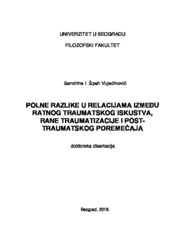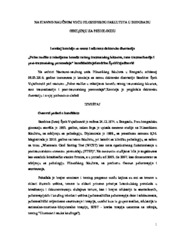Polne razlike u relacijama između ratnog traumatskog iskustva, rane traumatizacije i post-traumatskog poremećaja
Sex differences in relations between war traumatic experience, early traumatization and post-traumatic disorder
| dc.contributor.advisor | Knežević, Goran | |
| dc.contributor.other | Savić, Danka | |
| dc.contributor.other | Čabarkapa, Milanko | |
| dc.creator | Špeh Vujadinović, Sandrina I. | |
| dc.date.accessioned | 2016-10-10T06:32:06Z | |
| dc.date.available | 2016-10-10T06:32:06Z | |
| dc.date.available | 2020-07-03T10:06:02Z | |
| dc.date.issued | 2016-09-15 | |
| dc.identifier.uri | https://nardus.mpn.gov.rs/handle/123456789/6721 | |
| dc.identifier.uri | http://eteze.bg.ac.rs/application/showtheses?thesesId=3921 | |
| dc.identifier.uri | https://fedorabg.bg.ac.rs/fedora/get/o:13202/bdef:Content/download | |
| dc.identifier.uri | https://fedorabg.bg.ac.rs/fedora/get/o:13295/bdef:Izvestaj/download | |
| dc.identifier.uri | http://vbs.rs/scripts/cobiss?command=DISPLAY&base=70036&RID=48247311 | |
| dc.description.abstract | Iako literatura o PTSP-u generalno sugeriše veću vulnerabilnost ţena po pitanju ovog kliniĉkog entiteta, veza pola i posttraumatskog stresnog poremećaja je kompleksna, a nalazi studija ĉesto kontradiktorni i nedovoljno pouzdani usled metodoloških nedostataka. U cilju boljeg razumevanja posttraumatskog stresnog poremećaja i sliĉnosti i razlika koje postoje izmeĊu muškaraca i ţena u vezi sa njim, doktorska studija je imala za cilj utvrĊivanje polnih razlika u izloţenosti ratnim stresorima i ranim traumatskim dogaĊajima, kao i razlika u teţini posttraumatskog stresnog poremećaja i izraţenosti pojedinih grupa simptoma koje ĉine ovaj sindrom. Studijom je proveravana i struktura glavnih koncepata (PTSP, ratne i rane traume) i relacije koje postoje meĊu njima, odnosno utvrĊivano postojanje polnih razlika u tim domenima. Istraţivanje je deo projekta "Psihobiologija posttraumatskom stresnog poremećaja" (INCO-CT-2004-509213), raĊeno na uzorku od 559 ispitanika (muškarci – 280, ţene – 279). Grupe su ĉinili ispitanici starosti od 20 do 65 godina. Oba polno definisana poduzorka su ĉinile osobe traumatizovane ratom, pri ĉemu su u pribliţno jednakoj meribile obuhvaćene osobe sa aktuelnim PTSP, osobe sa PTSP u toku ţivota i osobe sa ratnim iskustvima bez istorije PTSP. Za procenu su korišćeni instrumenti: CAPS (Kliniĉka skala za procenu PTSP), UPRS-R (Upitnik za procenu ratnih stresora) i ETISR-SF (skraćena verzija Inventara za samoprocenu ranih trauma). Rezultati studije ukazuju na znatno veću izloţenost muškaraca svim tipovima ratnih tresora (veći broj stresora i uĉestalija izloţenost). Posebno velike razlike izmeĊu muškaraca i ţena su prisutne u pogledu ratnih dogaĊaja koji podrazumevaju aktivnije uĉešće u borbenim dejstvima (kod muškaraca dominiraju ovi stresori, dok su kod ţena zastupljenije „pozadinske― traume). Polne razlike u izloţenosti ranim traumama ukazuju na veće prisustvo fiziĉkog kaţnjavanja kod muškaraca, a veću izloţenost ţena emocionalnom zlostavljanju. Suprotno nalazima brojnih studija, po pitanju ranog seksualnog zlostavljanja nisu dobijene polne razlike. PoreĊenje muškaraca i ţena pokazuje postojanje jaĉeg posttraumatskog stresnog poremećaja kod muškaraca, ali se ispostavlja da je jaĉi PTSP posledica veće izloţenosti ratnim stresorima - polne razlike se gube kad se uvede kontrola ove varijable. Konfirmatornom faktorskom analizom dobijeno je da je struktura koncepata (latentni konstrukti PTSP-a, ratnih i ranih trauma) ista kod muškaraca i ţena, iako postoje razlike u konfiguraciji dimenzija kao i u varijansi indikatora koja nije objašnjena latentnim faktorima. Po pitanju relacija izmeĊu PTSP, ratnih i ranih trauma, polne razlike postoje i ukazuju na to da su kod ţena i rane i ratne traume u vezi sa PTSP u odraslom dobu, kao i da ţenama iskustvo ranih trauma povećava verovatnoću da će kasnije doţiveti više ratnih stresora. Kod muškaraca nije uoĉena veza ranih trauma ni sa kasnijom ratnom traumatizacijom, niti sa ratnim PTSP u odraslom dobu. Kod oba pola, što je jaĉa ratna traumatizacija, jaĉi je i posttraumatski stresni poremećaj, pri ĉemu je uticaj ratnih stresora na PTSP ipak nešto veći kod ţena. U radu su razmatrane i implikacije dobijenih nalaza na dijagnostiĉko-terapijsku praksu i dalja istraţivanja. | sr |
| dc.description.abstract | Although the PTSD literature generally suggests greater vulnerability of women in terms of this clinical entity, the relationship between sex and post-traumatic stress disorder is complex, and research findings are often contradictory and insufficiently reliable due to methodological shortcomings. In order to better understand the post-traumatic stress disorder and the similarities and differences that exist between men and women with regard to it, this doctoral study aimed at determining sex differences in exposure to war stressors and early traumatic events, as well as differences in the severity of post-traumatic stress disorder and prominence of certain groups of symptoms that make up this syndrome. The study also examined the structure of the main concepts (PTSD, war and early trauma) and relations which exist between them, and identified the presence of sex differences in these domains. The study was a part of the project ―Psychobiology of Posttraumatic Stress Disorder‖ and it was conducted on a sample of 559 subjects (males – 280, females – 279). Groups consisted of subjects aged 20 to 65. Both sub-samples (defined by sex) included war-traumatized subjects, with the approximately same number of people with current PTSD, people with life-time PTSD and war-traumatized people without the history of PTSD. The following instruments were used for the assessment: CAPS (Clinician-Administered PTSD Scale for DSM-IV), UPRS-R (War Stressors Assesment Questionnaire) and ETISR-SF (Early Trauma Inventory- Self Report- Short Form). The study results indicate a significantly greater exposure of males to all types of war stressors (greater number of stressors and more frequent exposure). Especially large differences between males and females are present with regard to war events that involve active participation in combat operations (these stressors dominate in males, while the "background" traumas are more represented among females). Sex differences in exposure to early traumas indicate a greater presence of physical punishment among men and greater exposure to emotional abuse among women. Contrary to the findings of numerous studies, concerning early sexual abuse, no sex differences were identified. Comparison of male and female samples showed the existence of a stronger PTSD in men, which turned out to be a consequence of their greater exposure to war stressors - after controlling for the influence of the level of exposure, sex differences regarding the severity of post-traumatic symptomatology were not found. Confirmatory factor analysis showed that the structure of concepts (latent constructs of PTSD, war traumas and early traumas) is the same in men and women, although there are differences in the configuration of dimensions as well as in the variance of indicators which is not explained by the latent factors. Regarding the relationship between PTSD, war traumas and early traumatisation, sex differences exist and they indicate that in women both early and war traumas are related to PTSD in adulthood, as well as that early traumas affect the probability of women‘s increased future exposure to war stressors. In men, no correlation of early trauma with either future war traumatisation or the PTSD in adulthood was identified. Both in men and women, higher level of war traumatization leads to more severe post-traumatic symptomatology, although this influence is somewhat stronger among females. The implications of the obtained findings for diagnostic and therapeutic practice and further research are also discussed. | en |
| dc.format | application/pdf | |
| dc.language | sr | |
| dc.publisher | Универзитет у Београду, Филозофски факултет | sr |
| dc.rights | openAccess | en |
| dc.rights.uri | https://creativecommons.org/licenses/by-nc-nd/4.0/ | |
| dc.source | Универзитет у Београду | sr |
| dc.subject | PTSP | sr |
| dc.subject | PTSD | en |
| dc.subject | posttraumatic stress disorder | en |
| dc.subject | sex differences | en |
| dc.subject | traumatic events | en |
| dc.subject | war stressors | en |
| dc.subject | early traumas | en |
| dc.subject | posttraumatski stresni poremećaj | sr |
| dc.subject | polne razlike | sr |
| dc.subject | traumatski dogaĎaji | sr |
| dc.subject | ratni stresori | sr |
| dc.subject | rane traume | sr |
| dc.title | Polne razlike u relacijama između ratnog traumatskog iskustva, rane traumatizacije i post-traumatskog poremećaja | sr |
| dc.title | Sex differences in relations between war traumatic experience, early traumatization and post-traumatic disorder | en |
| dc.type | doctoralThesis | en |
| dc.rights.license | BY-NC-ND | |
| dcterms.abstract | Кнежевић, Горан; Чабаркапа, Миланко; Савић, Данка; Шпех Вујадиновић, Сандрина И.; Полне разлике у релацијама између ратног трауматског искуства, ране трауматизације и пост-трауматског поремећаја; Полне разлике у релацијама између ратног трауматског искуства, ране трауматизације и пост-трауматског поремећаја; | |
| dc.identifier.fulltext | http://nardus.mpn.gov.rs/bitstream/id/27944/Disertacija4892.pdf | |
| dc.identifier.fulltext | http://nardus.mpn.gov.rs/bitstream/id/27945/IzvestajKomisije4892.pdf | |
| dc.identifier.fulltext | https://nardus.mpn.gov.rs/bitstream/id/27945/IzvestajKomisije4892.pdf | |
| dc.identifier.fulltext | https://nardus.mpn.gov.rs/bitstream/id/27944/Disertacija4892.pdf | |
| dc.identifier.rcub | https://hdl.handle.net/21.15107/rcub_nardus_6721 |



